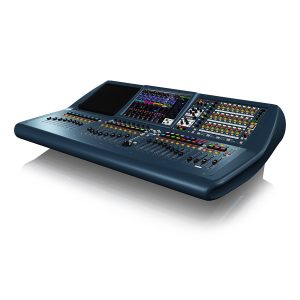คำอธิบาย
Tascam Sonicview 16 Digital Mixer With Multi-Environment Touch Screens
มิกเซอร์ดิจิตอล TASCAM Sonicview 16, 44 input ch (or 40 mono input ch and 2 stereo input ch) and 4 FX return, FPGA Mix Engine + 32-Bit / 96 kHz AD/DA, Dual 7″ Touchscreens + Motorized Faders, 16 HDIA Microphone Preamps, 16 XLR Mic/Line Input
The Tascam Sonicview 16 is a high powered mixing desk with motorised faders per channel, assignable function keys and a state of the art triple screen design. The TASCAM Sonicview 16 offers motorized channel faders in two banks of eight, plus a motorized stereo fader for the main bus. Above each bank of channel faders is a color touch panel that allows you to view entire mixer channels, or get down to details, controlling each parameter with your fingertip.
TASCAM Sonicview mixing consoles integrate beautifully with the rest of your system, thanks to built-in Dante networking, a 32-bit/96 kHz multi-channel USB audio interface, and plenty of I/O. No-compromise audio quality, including 54-bit float-point FPGA mixing, combines with ample signal processing, an expansion slot for additional connectivity, and wireless remote control to make TASCAM Sonicview mixers a next-generation choice for touring, installed sound, recording studios, and broadcasting.
Features:
- AD/DA conversion: 32 bit / 96 kHz
- Tascam HDIA microphone preamplifier (High-Definition Instrumentation Architecture)
- FPGA mixing engine with 54-bit floating-point processing and 96 kHz sampling rate
- 44 Input channels (40 mono, 2 stereo)
- 22 Flexible output busses + stereo sum with 31-band graphic EQ
- Visual Interactive Ergonomic Workflow (VIEW) interface provides intuitive operation with three view modes
- Multiple simultaneous views via two 7-inch colour touchscreens
- Latency: 2 × Fs (20.8 µs) in mixing engine, 0.51 ms analogue-to-analogue
- Integrated Dante interface with 64 inputs and outputs (supports redundancy, AES67, DDM and SMPTE 2110)
- USB audio interface with 32 inputs and outputs
- Internal two-track recording/playback to SD card or USB drive
- Four multi-effects processors
- 16 + 1 100 mm motorised faders
- 16 Encoders with colour LEDs
- 16 LC displays with colour LEDs for channel names as well as displays for input level and dynamic level reduction
- 18 Individually assignable buttons
- Seven user-defined fader levels and eight DCA groups
- Gigabit Ethernet connection (1000 BaseT)
- Remote control and offline editing via Tascam Sonicview software for Windows, macOS and iOS
- Two Tascam expansion slots (expansion cards available for 32-track SDXC recorders as well as MADI, AES/EBU and analogue signals – not included)
- Power switch with protection
















